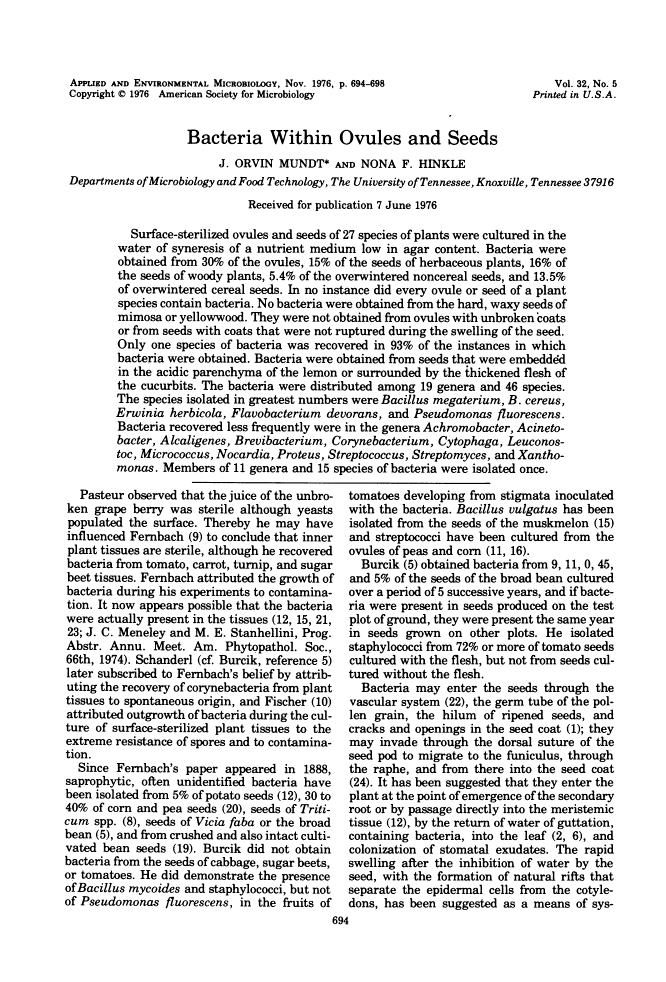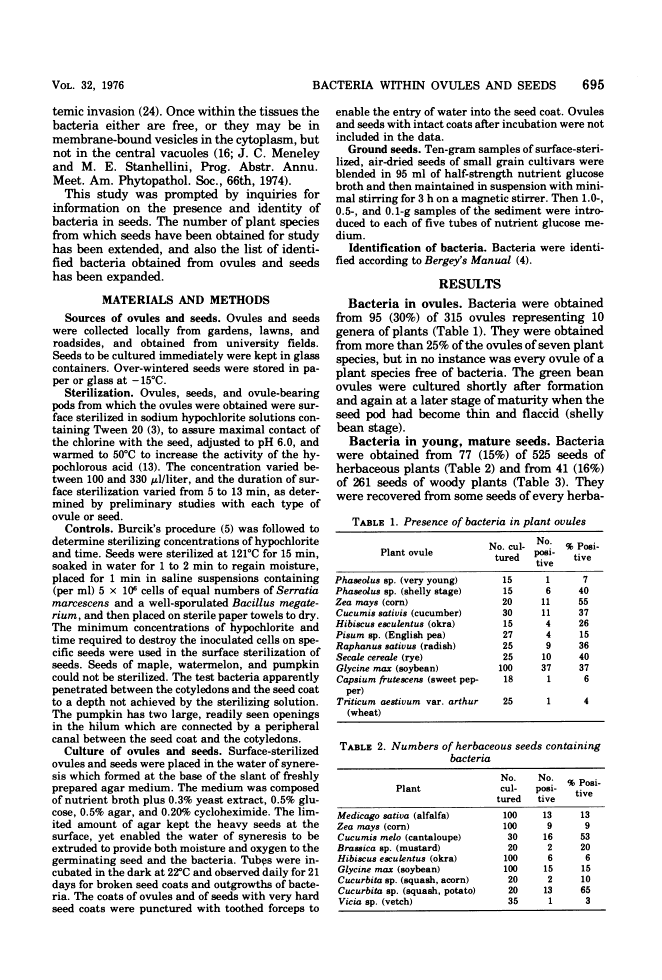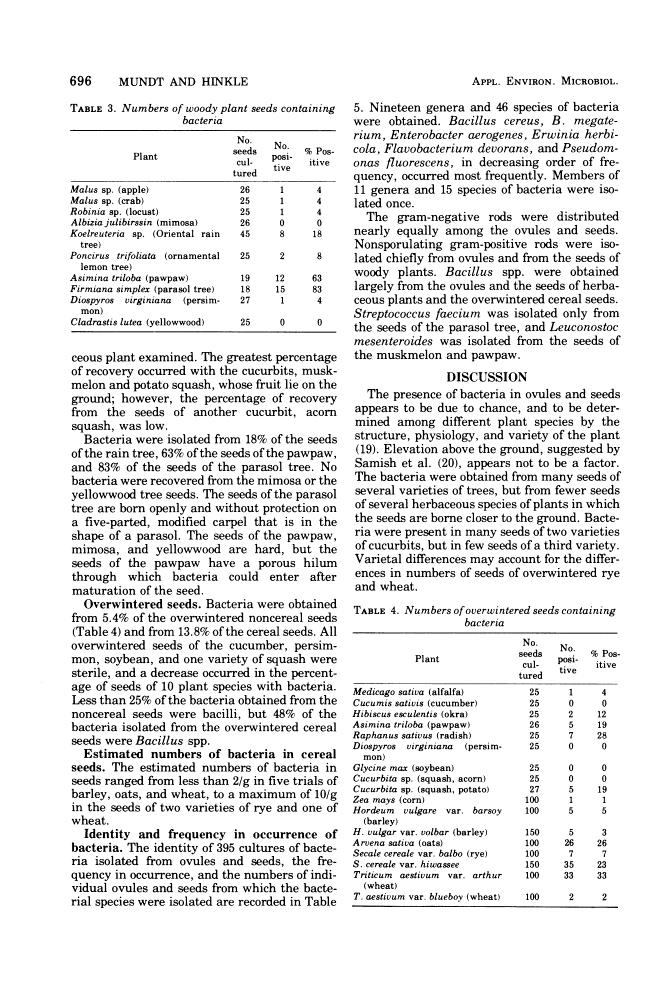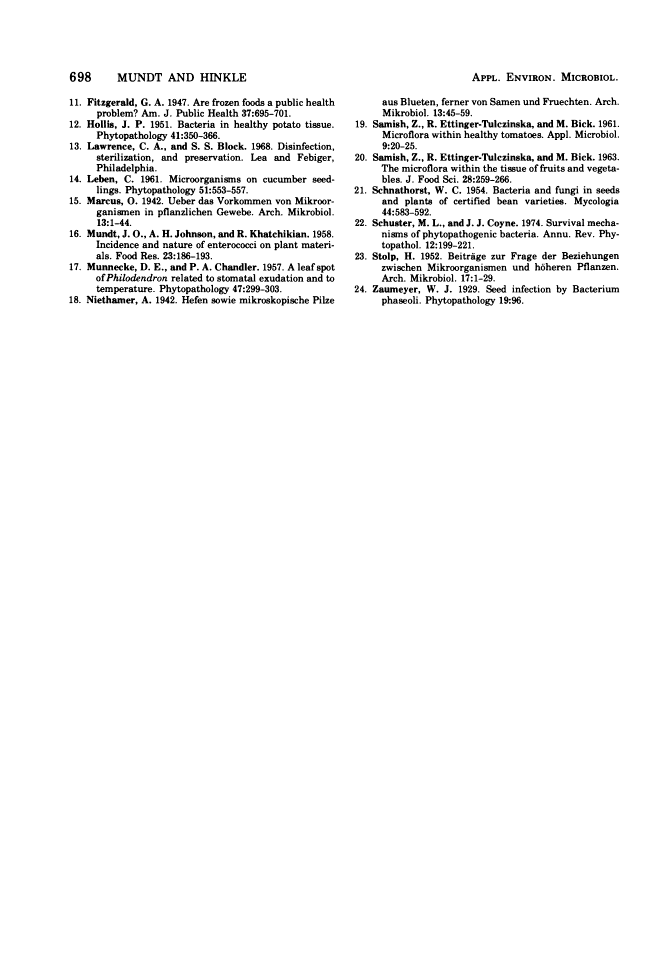Abstract
Free full text

Bacteria within ovules and seeds.
Abstract
Surface-sterilized ovules and seeds of 27 species of plants were cultured in the water of syneresis of a nutrient medium low in agar content. Bacteria were obtained from 30% of the ovules, 15% of the seeds of herbaceous plants, 16% of the seeds of woody plants, 5.4% of the overwintered noncereal seeds, and 13.5% of overwintered cereal seeds. In no instance did every ovule or seed of a plant species contain bacteria. No bacteria were obtained from the hard, waxy seeds of mimosa or yellowwood. They were not obtained from ovules with unbroken coats or from seeds with coats that were not ruptured during the swelling of the seed. Only one species of bacteria was recovered in 93% of the instances in which bacteria were obtained. Bacteria were obtained from seeds that were embedded in the acidic parenchyma of the lemon or surrounded by the thickened flesh of the cucurbits. The bacteria were distributed among 19 genera and 46 species. The species isolated in greatest numbers were Bacillus megaterium, B. cereus, Erwinia herbicola, Flavobacterium devorans, and Pseudomonas fluorescens. Bacteria recovered less frequently were in the genera Achromobacter, Acinetobacter, Alcaligenes, Brevibacterium, Corynebacterium, Cytophaga, Leuconostoc, Micrococcus, Nocardia, Proteus, Streptococcus, Streptomyces, and Xanthomonas. Members of 11 genera and 15 species of bacteria were isolated once.
Full text
Full text is available as a scanned copy of the original print version. Get a printable copy (PDF file) of the complete article (703K), or click on a page image below to browse page by page. Links to PubMed are also available for Selected References.
Selected References
These references are in PubMed. This may not be the complete list of references from this article.
- Blanchard RO, Hanlin RT. Effect of propylene oxide treatment on the microflora of pecans. Appl Microbiol. 1973 Nov;26(5):768–772. [Europe PMC free article] [Abstract] [Google Scholar]
- DOLD H, WITZENHAUSEN Weitere Beobachtungen über Vital-Inhibition. Zentralbl Bakteriol Orig. 1953;160(1-5):217–226. [Abstract] [Google Scholar]
- Fitzgerald GA. Are Frozen Foods a Public Health Problem? Am J Public Health Nations Health. 1947 Jun;37(6):695–701. [Abstract] [Google Scholar]
- SAMISH Z, ETINGER-TULCZYNSKA R, BICK M. Microflora within healthy tomatoes. Appl Microbiol. 1961 Jan;9:20–25. [Europe PMC free article] [Abstract] [Google Scholar]
Associated Data
Articles from Applied and Environmental Microbiology are provided here courtesy of American Society for Microbiology (ASM)
Full text links
Read article at publisher's site: https://doi.org/10.1128/aem.32.5.694-698.1976
Read article for free, from open access legal sources, via Unpaywall:
https://aem.asm.org/content/aem/32/5/694.full.pdf
Free to read at aem.asm.org
http://aem.asm.org/cgi/content/abstract/32/5/694
Free after 4 months at aem.asm.org
http://aem.asm.org/cgi/reprint/32/5/694
Citations & impact
Impact metrics
Article citations
Assembly and Function of Seed Endophytes in Response to Environmental Stress.
J Microbiol Biotechnol, 33(9):1119-1129, 30 May 2023
Cited by: 3 articles | PMID: 37311706 | PMCID: PMC10580892
Review Free full text in Europe PMC
Seed endophytic bacterial profiling from wheat varieties of contrasting heat sensitivity.
Front Plant Sci, 14:1101818, 06 Apr 2023
Cited by: 5 articles | PMID: 37089648 | PMCID: PMC10117849
Characterization of the endophytic bacterial community of Bituminaria bituminosa plant grown in vitro and its interaction with the plant extract.
Front Plant Sci, 13:1076573, 18 Jan 2023
Cited by: 0 articles | PMID: 36743570 | PMCID: PMC9889976
Maize seed endophytes.
Mol Plant Pathol, 24(7):801-810, 22 Nov 2022
Cited by: 9 articles | PMID: 36416063 | PMCID: PMC10257045
Review Free full text in Europe PMC
Single Seed Microbiota: Assembly and Transmission from Parent Plant to Seedling.
mBio, 13(6):e0164822, 12 Oct 2022
Cited by: 9 articles | PMID: 36222511 | PMCID: PMC9765463
Go to all (70) article citations
Similar Articles
To arrive at the top five similar articles we use a word-weighted algorithm to compare words from the Title and Abstract of each citation.
FOOD MICROORGANISMS INFLUENCING THE GROWTH OF STAPHYLOCOCCUS AUREUS.
Appl Microbiol, 11:513-516, 01 Nov 1963
Cited by: 13 articles | PMID: 14075051 | PMCID: PMC1058041
Naturally occurring phenanthrene degrading bacteria associated with seeds of various plant species.
Int J Phytoremediation, 18(4):423-425, 01 Jan 2016
Cited by: 0 articles | PMID: 26515514
MICROBIAL ECOLOGY OF ACTIVATED SLUDGE. I. DOMINANT BACTERIA.
Appl Microbiol, 12:412-417, 01 Sep 1964
Cited by: 30 articles | PMID: 14215970 | PMCID: PMC1058146
Bacterial surface translocation: a survey and a classification.
Bacteriol Rev, 36(4):478-503, 01 Dec 1972
Cited by: 325 articles | PMID: 4631369 | PMCID: PMC408329
Review Free full text in Europe PMC










